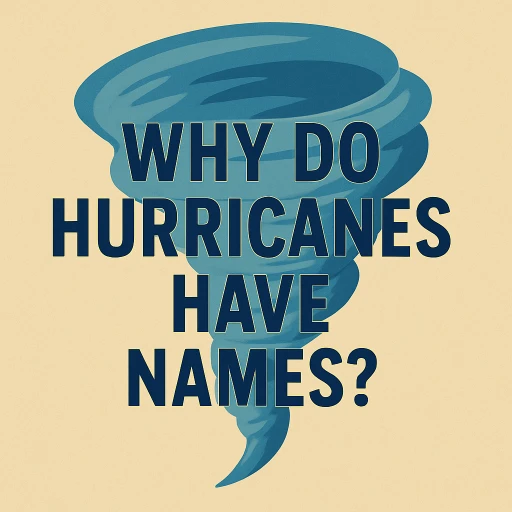Every summer, coastal residents start hearing familiar names on the news — Andrew, Katrina, Ian, Irma. Each one carries memories of storms that reshaped communities and changed lives. But have you ever wondered why hurricanes have names in the first place? And more importantly, how can you protect your home when one of those names appears on the radar?
The Real Reason Hurricanes Have Names
Hurricanes didn’t always have personal names. Before the 1950s, meteorologists used geographic coordinates or the year and order of the storm. That caused confusion, especially when multiple storms formed at the same time. The system was replaced with names so people could track storms more easily and remember which warnings applied to them.
- The first official list came in 1953. Initially, only female names were used. In 1979, male names were added, alternating with female ones to make the process fair and easier to follow. The names repeat every six years unless a hurricane is so destructive that its name is permanently retired. That’s why we’ll never see another Update : Andrew, Wilma, Helene, Milton, Katrina, Irma, Harvey, or Maria.
How the Naming System Works
Each year, the World Meteorological Organization prepares a list of 21 names in alphabetical order. They skip the letters Q, U, X, Y, and Z because there aren’t enough familiar names starting with them. If more than 21 storms form — which has happened in recent active seasons — a backup list is used.
This naming system helps emergency agencies communicate faster and more clearly. When a storm is named, people pay attention. It’s no longer just a number; it’s a personality with potential power.
The Link Between Names and Preparation
While the name itself doesn’t make a hurricane stronger, it does influence how people react. Studies have shown that storms with human names feel more personal, which often triggers faster preparation. But the truth is, whether the storm is called “Hurricane Alex” or “Hurricane Zoe,” you need the same level of protection — and that starts with your home.
If you live in a hurricane-prone area, Hurricane Screens are one of the smartest defenses you can invest in. These screens are engineered to withstand flying debris, heavy winds, and the pressure changes that can shatter windows and doors. You can learn more about these systems by visiting Atlas Armor’s contact page to speak directly with a protection specialist.
What Makes Atlas Armor Screens Different
Atlas Armor builds more than just screens — they build confidence. Every system is made from DuPont™ Kevlar®, a UV-protected material known for its strength and flexibility. The design is engineered to stay steady in extreme winds, while its tight weave stops debris and resists air pressure that could otherwise damage your home.
Their versatility makes them ideal for patios, lanais, doors, and wide openings, giving full coverage without blocking your view. These aren’t decorative mesh panels — they’re tested and certified protection built to perform when conditions turn dangerous.
Atlas Armor’s screens are even rated to defend against EF0, EF1, and EF2 tornadoes (65–135 mph winds), which often accompany hurricanes and tropical storms. Few products on the market can match that level of durability.
Fast delivery, no waiting: orders ship to your local dealer in about four to six weeks, often sooner. Whether you’re protecting a single-family home or a large commercial property, you won’t wait months for coverage.
Why homeowners choose Atlas Armor:
- Over 11 years of storm protection experience
- Zero product failures in 55 major windstorms
- The only company offering a wind-only damage warranty
- Certified by Miami-Dade County and Texas Department of Insurance (TDI)
- Fast dealer delivery within 4–6 weeks
That’s not marketing talk — it’s a track record proven through real storms and verified testing.
What Makes Hurricane Screens Better Than Shutters
Traditional shutters block your view and make your home dark for days. Hurricane Screens are transparent, flexible, and lightweight. They protect your home while letting in natural light and maintaining visibility. You can roll them down in minutes, stay safe, and still see outside while the storm passes.
If you’re considering an upgrade before the next hurricane season, reach out through this contact page to explore certified Screens that fit your property and budget.
Preparing for the Next Name on the List
Whether the forecast says “Hurricane Milton” or “Hurricane Nadine,” the plan is always the same: stay informed, secure your home, and act early. It’s always safer and far more cost-effective to prevent damage than to replace something after it fails.
Modern technology has made hurricane preparation more effective than ever — and Hurricane Screens for Protection play a big part in that. Atlas Armor designs them to stand up to real storm conditions, giving you one less thing to worry about when the winds start rising. To get expert guidance or a quote, visit our contact page and find out how these screens can protect your home for years to come.
Staying Calm When the Next Name Appears
Every hurricane season brings a new list of names, and while we can’t control which one will make landfall, we can control how ready we are. Investing in proven protection is the best decision for your home and peace of mind.
When the next storm builds momentum, your home stays steady behind Atlas Armor’s protection.







